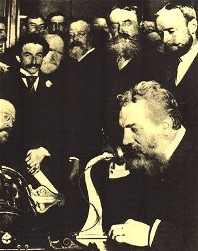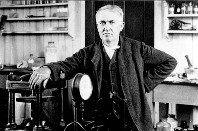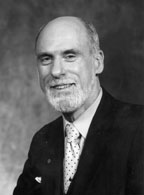|
 "On
March 10, 1876, in Boston, Massachusetts, Alexander Graham Bell invented
the telephone. Thomas Watson fashioned the device itself; a crude thing
made of a wooden stand, a funnel, a cup of acid, and some copper wire.
But these simple parts and the equally simple first telephone call --
"Mr. Watson, come here, I want you!" -- belie a complicated past. Bell
filed his application just hours before his competitor, Elisha Gray,
... What's more, though
neither man had actually built a working telephone, Bell made his
telephone operate three weeks later using ideas outlined in Gray's
Notice of Invention, methods Bell did not propose in his own patent "On
March 10, 1876, in Boston, Massachusetts, Alexander Graham Bell invented
the telephone. Thomas Watson fashioned the device itself; a crude thing
made of a wooden stand, a funnel, a cup of acid, and some copper wire.
But these simple parts and the equally simple first telephone call --
"Mr. Watson, come here, I want you!" -- belie a complicated past. Bell
filed his application just hours before his competitor, Elisha Gray,
... What's more, though
neither man had actually built a working telephone, Bell made his
telephone operate three weeks later using ideas outlined in Gray's
Notice of Invention, methods Bell did not propose in his own patent ,"
Tom Farley from his Telecom history
page at
Privateline.com
From the electric
phone to the Internet
By Keith Newman
The timeline of telecommunications is as complex as a spider's web but
certain innovations continue to propel us inextricably deeper into the
information age.
This past 100 years has seen more pervasive change than history has
recorded for the previous millennia. With fire, water, earth and air
harnessed to some degree, and steel and steam opening up industrial
horizons, humanity’s curiosity quickly extended to the harnessing
lightning and splitting the atom.
Alexander Graham Bell was trying to improve the morse code telegraph
when he came up with the idea for the telephone. Repair mechanic Thomas
Watson helped Bell devise an apparatus for transmitting sound by
electricity. On April 6, 1875, Bell obtained a patent for the multiple
telegraph, and began writing the specifications for the telephone.
Far speaking's far off origins
A combination of two Greek words, 'tele' (meaning far off) and
'phone' (meaning voice or sound) became the term for
'far-speaking'.
Distance communication by means other than voice had early
associations with music, dating to the early 1800s. Charles
Wheatstone co-inventor of the telegraph, applied the term
'telephonic' to describe his invention as an 'enchanted lyre'
which transmitted music from one room to another.
Speaking tubes were used on steamships and trains and in office
walls and households to carry on conversations between parties
in distant rooms. Victorian children played with string
telephones (small tin cylinders with paper drumheads attached by
a string).It was only to be a matter of time before the
application of electricity to the concept of the string
telephone would be realized.
Philipp Reis began his research in 1860, using the 'hollowed-out
bung of a beer barrel, a sausage skin, a violin, and a
knitting-needle' and called his invention a 'telephon' (Young,
1991, p. 5). Reis came close to inventing the electric
telephone, missing only by a 'turn of a screw' (Brooks, 1976, p.
36). However, the person most closely associated with the true
invention of the electric telephone remains Alexander Graham
Bell (source: About.coms
History of Communications ) |
He made his first conversation in Boston on March 10, 1876.
As he was
preparing to speak into the trumpet mouthpiece of his device he
spilled a jar of battery acid over his clothes. The words "Mr Watson,
come in here, I want you" were heard clearly in the next room where
Watson was tuned to the earpiece. When news of the invention got out the
chief engineer at the US Post Office declared there would be no need for
such a device as there were already plenty of messenger boys. Bell went
on to enable transmission of sound through a beam of light - the forerunner
of today's fibre optic systems.
 Thomas
Edison, while trying to record telegraph messages by drawing a paraffin
-coated paper tape at high speed through a receiving instrument embossed
with dots and dashes, stumbled on the idea for the cylinder phonograph.
On December 6, 1877 Edison recited and reproduced almost perfectly his
rendition of Mary Had A Little before a small group of witnesses. Thomas
Edison, while trying to record telegraph messages by drawing a paraffin
-coated paper tape at high speed through a receiving instrument embossed
with dots and dashes, stumbled on the idea for the cylinder phonograph.
On December 6, 1877 Edison recited and reproduced almost perfectly his
rendition of Mary Had A Little before a small group of witnesses.
John Logie Baird invented mechanical television in London in late 1925
which was quickly overtaken by electronic television. He also made the
first trans-Atlantic television transmission and invented radar and
fibre optics. At Bell Laboratories another startling breakthrough would
put all those previous discoveries into a new context through
miniaturization.
On December 23, 1947 John Bardeen, Walter Brattain, and William Shockley
invented the transistor. However it wasn't made available to US
manufacturers until 1956, when a seven year-old
antitrust
suit against AT&T, the owners of Bell Labs, was settled required it give
away licenses to manufacture transistors for US companies to replace
vacuum tubes in computers.
 Internet evolution: Internet evolution:
“Internet refers to the global information system that - (i) is
logically linked together by a globally unique address space based on
the Internet Protocol (IP) or its subsequent extensions/follow-ons; (ii)
is able to support communications using the Transmission Control
Protocol/Internet Protocol (TCP/IP) suite or its subsequent
extensions/follow-ons, and/or other IP-compatible protocols; and (iii)
provides, uses or makes accessible, either publicly or privately, high
level services layered on the communications and related infrastructure
described herein,” - Federal Networking Council (FNC) resolution,
unanimously passed on October 24, 1995, defining the term Internet in
consultation with members of the Internet and intellectual property
rights communities.
1959: Polish immigrant
Paul
Baran joined RAND a US
‘think tank’ RAND and began working on ways to solve
cold war related military challenges, including how to ensure long
distance telephone network and military command and control networks
could survivie survive a nuclear attack. He devised the idea of
decentralised switching so the network could operate even if many of its
links and switching nodes had been destroyed.
All nodes would be
created equal, and able to
originate, pass and receive messages
with their own unique addresses. Many others began working on similar
solution around the same time that would feed into what would become the
first steps toward creating the Internet
1961:
The first paper on ‘packet
switching theory’ had been written by at MIT by Leonard Kleinrock.
His book on computer networking published in 1964, convinced his peers
of the theoretical feasibility of communications using packets rather
than circuits.
1962:
J.C.R. Licklider, the first head of the computer research program at
the Pentagon’s Defense Advanced Research Projects Agency (DARPA)
begins discussing his ‘Galactic Network’. He envisioned “a globally
interconnected set of computers through which everyone could quickly
access data and programs from any site”.
1966: MIT researcher
Lawrence G. Roberts further developed the computer network
concept at DARPA, and published his design for the ARPAnet and
began collaborating with a team from the National Physics Laboratory (NPL)
in Middlesex, England and Paul Baran’s team at the RAND group which had
produced a paper on packet switching networks for secure voice
communications in the military in 1964. It became evident that the three
groups had been working on the same objectives concurrently without
knowing of each other’s efforts.
1969:
A fourth host computer was connected to the US military-base
ARPAnet.
The building blocks for what was to become the Internet were in now in
place.
1973:
Vinton Cerf, and fellow US Department of Defence Advanced
Research Projects Agency (DARPA) scientist Robert Kahn worked on a a
diagram on the back of an envelope. Their design
would become become known as the
Transmission Control Protocol (TCP)
and more easily allow different kinds of networks to interconnect. It
showed showed how the defence network
combined with packet radio and satellite networks could evolve into what
was to become the Internet.
1976: Leonard Kleinrock at MIT
who helped develop packet switching theory, published the first book on
the ARPAnet, which helped spread the lore of packet switching
networks.
“On
Jan. 1, 1983, 400 or so computers hooked to what was then called
ARPAnet and a communications protocol called TCP/IP. It was TCP/IP
that allowed multiple networks to coexist and permitted applications
like the World Wide Web to develop and thrive. In other words, it made
the Internet what it is today. "This is a major milestone consider the
1st January 1983 date to be the real rollout of (the) Internet," said
Vint Cerf, so-called father of the Internet
We’re a long way from waving arms and flags in semaphore and Samuel
Morse’s electronic dot-dot-dash coded messages. Today the internet
presents such a pervasive and powerful force for communication and
change it has the world careering into a science fictional 21st
century like a freight train with no brakes.
|
 "On
March 10, 1876, in Boston, Massachusetts, Alexander Graham Bell invented
the telephone. Thomas Watson fashioned the device itself; a crude thing
made of a wooden stand, a funnel, a cup of acid, and some copper wire.
But these simple parts and the equally simple first telephone call --
"Mr. Watson, come here, I want you!" -- belie a complicated past. Bell
filed his application just hours before his competitor, Elisha Gray,
... What's more, though
neither man had actually built a working telephone, Bell made his
telephone operate three weeks later using ideas outlined in Gray's
Notice of Invention, methods Bell did not propose in his own patent
"On
March 10, 1876, in Boston, Massachusetts, Alexander Graham Bell invented
the telephone. Thomas Watson fashioned the device itself; a crude thing
made of a wooden stand, a funnel, a cup of acid, and some copper wire.
But these simple parts and the equally simple first telephone call --
"Mr. Watson, come here, I want you!" -- belie a complicated past. Bell
filed his application just hours before his competitor, Elisha Gray,
... What's more, though
neither man had actually built a working telephone, Bell made his
telephone operate three weeks later using ideas outlined in Gray's
Notice of Invention, methods Bell did not propose in his own patent Thomas
Edison, while trying to record telegraph messages by drawing a paraffin
-coated paper tape at high speed through a receiving instrument embossed
with dots and dashes, stumbled on the idea for the cylinder phonograph.
On December 6, 1877 Edison recited and reproduced almost perfectly his
rendition of Mary Had A Little before a small group of witnesses.
Thomas
Edison, while trying to record telegraph messages by drawing a paraffin
-coated paper tape at high speed through a receiving instrument embossed
with dots and dashes, stumbled on the idea for the cylinder phonograph.
On December 6, 1877 Edison recited and reproduced almost perfectly his
rendition of Mary Had A Little before a small group of witnesses. Internet evolution:
Internet evolution: